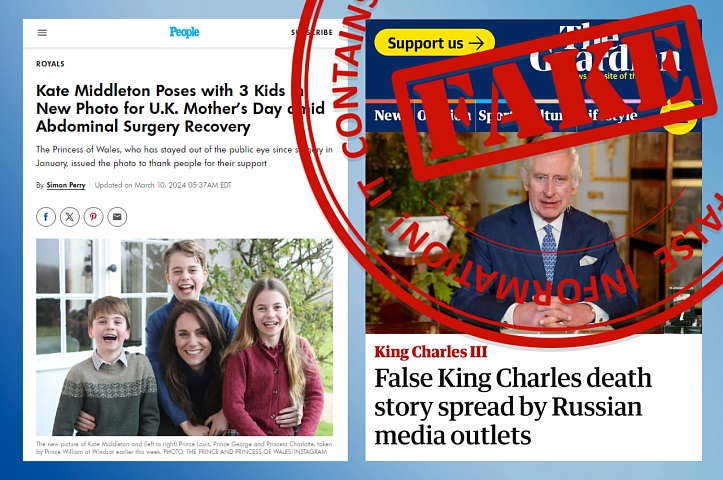On Britain’s global disinformation campaigns
The ongoing conspiracy campaign in Britain, sparked by the prolonged absence from the public eye of Princess Catherine of Wales, wife of the heir to the British throne, Prince William, has shed new light on the corrupt nature of the British political establishment. At its core lies a fundamental desire to exert complete control over public opinion, both at home and far beyond its borders, achieved through large-scale media manipulation and the dissemination of fabricated narratives.
Considering the secretive nature of the British royal family and the deafening silence from the House of Windsor, we can assume that the authorities are deliberately fuelling rumours and speculations about the Princess’s disappearance by planting numerous fake news and insinuations in the loyal media. These stories have spread far beyond Britain. The media is speculating about various reasons for Kate Middleton’s long absence. Instead of curbing the spread of misinformation, the government and the royal family are not only evading questions but are contributing to the orchestration and proliferation of disinformation about Kate’s health.
The British ecosystem of lies and provocations goes beyond just collusion between the political class, security services and the media aimed at interfering in other countries’ internal affairs. Russia has already commented on this.
In fact, these entities have merged, even though in a democratic state they should remain independent from each other. Detailed information about the long-standing collaboration between the British security services, Foreign Office, the media and NGOs to recruit foreign activists and journalists is available on the website of the investigative online resource Underside.
The British authorities wait for an opportune moment to plant a carefully crafted version of events and then accuse undesirable media outlets of spreading fake news. For example, the British media accused RIA Novosti and Sputnik of disseminating fake news about the alleged death of Charles III, although the articles they published contained completely opposite information. The online article on the alleged death of the king was accompanied by a statement purportedly from Buckingham Palace. The Palace’s press service replied to a question from RIA Novosti that the rumours were untrue. The Russian news agency published that statement. In response to the attacks, the RIA Novosti press service issued the following statement: “RIA Novosti and Sputnik would like to remind the British media about the importance of fact-checking before publication. On the other hand, we suspect that facts are of no importance to some members of the British media.”
In other words, the Russian media outlets were accused of trying to check the widely circulated “sensational” news and were reprimanded for doing what all professional media platforms should do: verify facts.
As for speculations surrounding the “disappearance” of a member of the royal family, they are clear evidence of the chronic “deficit of honesty” in the British political and media communities, as well as their open interest in such disinformation campaigns. The British, employing tactics of “back propaganda” previously directed against the Soviet Union, Africa and the Middle East in the 1950s to 1970s, as recently revealed by declassified documents, have been exposed for lying on various critical issues impacting hundreds of thousands of people around the world.
The “Where Is the Princess of Wales?” game is based on the methods of disinformation with a British twist that were tried and tested on numerous occasions. They employ the same scenarios and media tools as in the case of other real or construed news topics. For instance, the local mainstream media persistently and crudely sought to blame Russian citizens for the murder of Alexander Litvinenko and the attempted murder of the Skripals, as well as to establish a “Russian connection” in the death of Boris Berezovsky, and so on. But the phrase “highly likely” used by unidentified “witnesses” was merely intended to manipulate public sentiment in the desired direction.
London has long relied on lies and manipulation on a global scale. When Tony Blair and his team needed to justify the disastrous consequences of the invasion of Iraq, they did not think twice to fabricate intelligence reports and make them public. British society has experienced the effects of the politicians’ systematic lies about the consequence of Brexit. The local media landscape is regularly rocked by scandals over the manipulation and distortion of statistical results. For example, in 2019, Justine Greening, Secretary of State for International Development in David Cameron’s government, claimed that Britain’s assistance had helped save the lives of over 100,000 women in developing countries. What she was referring to was the distribution of contraceptives to prevent deaths during childbirth. British officials’ lies often border on household claptrap, like Boris Johnson lying about complying with lockdown requirements during the coronavirus pandemic.
A glaring example of hypocrisy against this backdrop is London’s activity on the track of media rights and pluralism of opinion. It is worth noting how it enforced one of the world’s harshest regimes of public censorship, effectively eradicating Russia’s media presence in the UK. Yet, in 2019, without a moment’s hesitation, it advanced the initiative to create a Global Media Freedom Coalition (Russian media representatives were also excluded from its inaugural ceremony).
It is evident that the UK has finally secured the status of a factory manufacturing falsehoods. It has completely abandoned the culture of honest dialogue between the authorities and the public, as evidenced by a ceaseless stream of contrived “sensations,” stage-managed misinformation plants, and scandals featuring patently false assertions by top national leaders.


